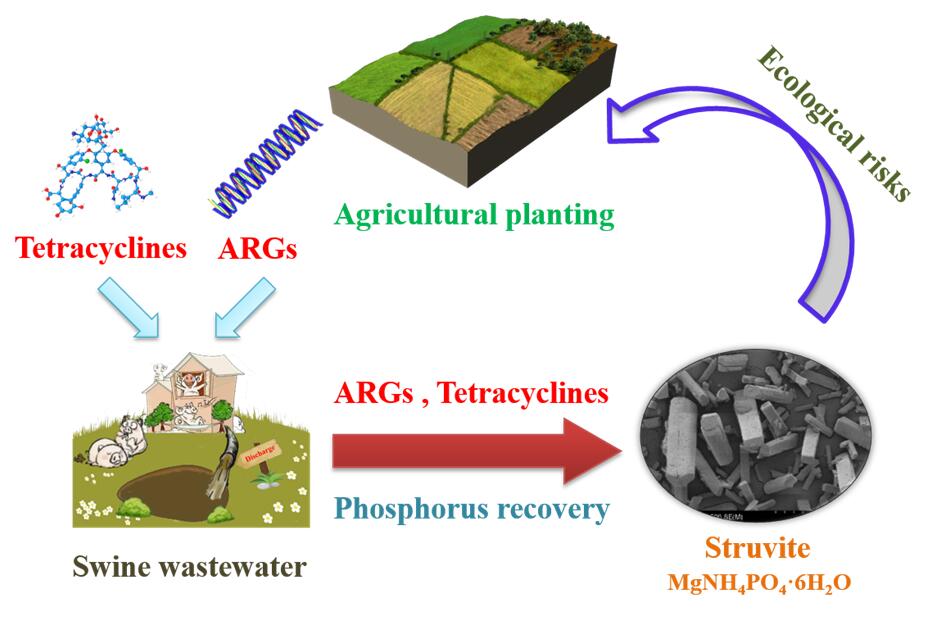Phosphorus is an essential nutrient for all lives. Phosphorus is involved in the process of material and energy transmission and storage in the biological organisms. Phosphorus exists in the phospholipid bilayer, which forms the basic skeleton of cell membrane. It is also an important component of DNA (deoxyribonucleic acid) and RNA (ribonucleic acid), which are used by living organisms to reproduce and function in everyday life.
The flow of phosphorus in nature is a one-way flow, starting with the mining of phosphate ore, following with producing phosphate fertilizer for agriculture, transforming to the fruits, vegetables and meat on the dinner table, and finally ending up in the ocean as the sediments. On the other hand, due to the continuous increase of the world population, people's demand for food has increased sharply, and the demand for phosphorus resources is also on the rise. It is estimated that the phosphate ore will run out within the next 100 years.

Fig. 1. The schematic diagram of phosphorus cycle in nature (This picture comes from literature)
Swine wastewater: "Rich mine" of phosphorus resources
With the development of economy and the continuous improvement of people's living standard, the demand for pork is increasing, and a large number of large-scale and intensive farms have emerged. It has been reported that more than 500 million pigs are produced and then processed into 50 million tons of pork per year in China, which also discharge a large volume of swine wastewater rich in nitrogen and phosphorus. It has been estimated that a pig can generate 30 kg of waste water every day, suggesting that 11 tons of wastewater can be produced for one pig annually. For an animal farming plant with 35,000 pigs, the pollution load is equivalent to that of a town with 100,000 people. According to the China Communique on the Second National Survey of Pollution Sources issued in the Year 2020, there were 378.8 thousand intensive animal farming enterprises in China, and they discharged 80.4 thousand tons of phosphorus in the Year 2017, which has become the main source of environmental pollution, and given rise to eutrophication and red tide in many lakes in China. Generally, phosphorus concentrations in swine wastewater reach to 100-250 mg/L. Therefore, it can be regarded as a "rich mine" of phosphorus resources.
There are several methods of phosphorus recovery from wastewater, including adsorption, biological strengthening, precipitation and crystallization, etc. At present, struvite crystallization method is predominantly used in livestock wastewater. It has the advantages of fast reaction speed and high phosphorus recovery efficiency. Struvite (MgNH4PO4·6H2O) is a kind of crystal, which contains nitrogen and phosphorus and is an excellent slow-release fertilizer that can be directly used in agriculture. Under alkaline conditions, struvite is produced by chemical reactions of different ions, including Mg2+, NH4+ and PO43-. The reaction equation of struvite crystallization is as follows:
Mg2++NH4++PO43-+6H2O→MgNH4PO4·6H2O
Unnegligible contamination in struvite recovery from wastewater: Antibiotic resistance
As to intensive pig farming, normally a significant amount of antibiotics are dosed into the feed for the purposes of promoting animal growth and preventing diseases. Nevertheless, only a small amount of antibiotics will be absorbed due to the poor digestion ability of animals’ guts, which results in about 30-90% antibiotics being discharged into the environment in the form of parent or metabolite. The discharged antibiotics will not only pose direct toxicity to animals and plants, but also bring about selective pressure on microorganisms in the environment, thus promoting the reproduction of antibiotic resistance bacteria and the spread of antibiotic resistance genes.
Presently, antibiotic resistance has been listed as an emerging environmental pollution by the World Health Organization, which seriously threatens human health. It has been estimated that antibiotic resistance is linked to 700 thousand deaths a year worldwide, and scientists predict it could cause as many as 10 million deaths by 2050. Therefore, it is necessary to consider the residues of antibiotics and resistance genes during phosphorus recovery from livestock and poultry wastewater. China is a big country in the production and use of veterinary antibiotics. Antibiotic resistance caused by animal breeding has become a new environmental pollution that cannot be ignored.

Fig. 2. Schematic diagram of antibiotics migration (The picture comes from network)
Recently, the Wastewater Treatment and Nutrient Recovery research group of the Institute of Urban Environment, Chinese Academy of Sciences carried out a study on struvite recovery from real swine wastewater. It was found that tetracyclines (TCs) and relevant antibiotic resistance genes (ARGs) had significant residues in the recovered products. However, their concentrations did not show correlative dependence, suggesting that predominant factors affecting TCs and ARGs transports were different. Further investigation found that the residues of TCs and ARGs were closely related to various components in the recovered products: (1) the mineral components of the recovered products, including struvite, K-struvite and amorphous calcium phosphate, did not display significant effects on TCs residues, while organic matters and heavy metals could promote TCs migration; (2) for ARGs, the heavy metals and mineral components including struvite, K-struvite and amorphous calcium phosphate posed influences, which might be the result of multiple interactions. These outcomes suggested that there might be risk of the transfer and transmission of antibiotic resistance in the environment during phosphorus recovery from wastewater. In order to prevent this risk, the important factors affecting antibiotic and resistance gene transport need to be screened out separately.

Fig. 3. Transport of antibiotic resistance genes during phosphorus recovery from swine wastewater
This study has been published on Environmental Pollution recently titled " Struvite crystallization induced the discrepant transports of antibiotics and antibiotic resistance genes in phosphorus recovery from swine wastewater".